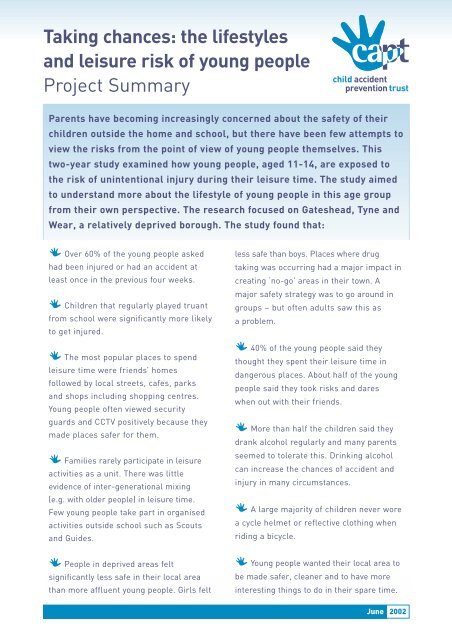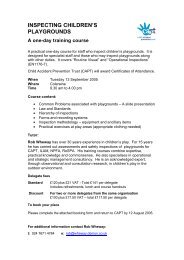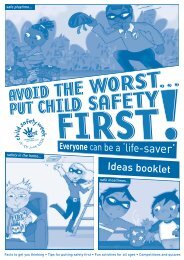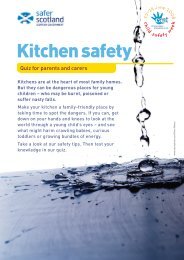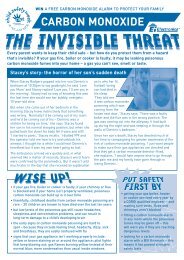Taking chances: the lifestyles and leisure risk of young people ...
Taking chances: the lifestyles and leisure risk of young people ...
Taking chances: the lifestyles and leisure risk of young people ...
You also want an ePaper? Increase the reach of your titles
YUMPU automatically turns print PDFs into web optimized ePapers that Google loves.
<strong>Taking</strong> <strong>chances</strong>: <strong>the</strong> <strong>lifestyles</strong><br />
<strong>and</strong> <strong>leisure</strong> <strong>risk</strong> <strong>of</strong> <strong>young</strong> <strong>people</strong><br />
Project Summary<br />
Parents have becoming increasingly concerned about <strong>the</strong> safety <strong>of</strong> <strong>the</strong>ir<br />
children outside <strong>the</strong> home <strong>and</strong> school, but <strong>the</strong>re have been few attempts to<br />
view <strong>the</strong> <strong>risk</strong>s from <strong>the</strong> point <strong>of</strong> view <strong>of</strong> <strong>young</strong> <strong>people</strong> <strong>the</strong>mselves. This<br />
two-year study examined how <strong>young</strong> <strong>people</strong>, aged 11-14, are exposed to<br />
<strong>the</strong> <strong>risk</strong> <strong>of</strong> unintentional injury during <strong>the</strong>ir <strong>leisure</strong> time. The study aimed<br />
to underst<strong>and</strong> more about <strong>the</strong> lifestyle <strong>of</strong> <strong>young</strong> <strong>people</strong> in this age group<br />
from <strong>the</strong>ir own perspective. The research focused on Gateshead, Tyne <strong>and</strong><br />
Wear, a relatively deprived borough. The study found that:<br />
Over 60% <strong>of</strong> <strong>the</strong> <strong>young</strong> <strong>people</strong> asked<br />
had been injured or had an accident at<br />
least once in <strong>the</strong> previous four weeks.<br />
Children that regularly played truant<br />
from school were significantly more likely<br />
to get injured.<br />
The most popular places to spend<br />
<strong>leisure</strong> time were friends’ homes<br />
followed by local streets, cafes, parks<br />
<strong>and</strong> shops including shopping centres.<br />
Young <strong>people</strong> <strong>of</strong>ten viewed security<br />
guards <strong>and</strong> CCTV positively because <strong>the</strong>y<br />
made places safer for <strong>the</strong>m.<br />
Families rarely participate in <strong>leisure</strong><br />
activities as a unit. There was little<br />
evidence <strong>of</strong> inter-generational mixing<br />
(e.g. with older <strong>people</strong>) in <strong>leisure</strong> time.<br />
Few <strong>young</strong> <strong>people</strong> take part in organised<br />
activities outside school such as Scouts<br />
<strong>and</strong> Guides.<br />
less safe than boys. Places where drug<br />
taking was occurring had a major impact in<br />
creating ‘no-go’ areas in <strong>the</strong>ir town. A<br />
major safety strategy was to go around in<br />
groups – but <strong>of</strong>ten adults saw this as<br />
a problem.<br />
40% <strong>of</strong> <strong>the</strong> <strong>young</strong> <strong>people</strong> said <strong>the</strong>y<br />
thought <strong>the</strong>y spent <strong>the</strong>ir <strong>leisure</strong> time in<br />
dangerous places. About half <strong>of</strong> <strong>the</strong> <strong>young</strong><br />
<strong>people</strong> said <strong>the</strong>y took <strong>risk</strong>s <strong>and</strong> dares<br />
when out with <strong>the</strong>ir friends.<br />
More than half <strong>the</strong> children said <strong>the</strong>y<br />
drank alcohol regularly <strong>and</strong> many parents<br />
seemed to tolerate this. Drinking alcohol<br />
can increase <strong>the</strong> <strong>chances</strong> <strong>of</strong> accident <strong>and</strong><br />
injury in many circumstances.<br />
A large majority <strong>of</strong> children never wore<br />
a cycle helmet or reflective clothing when<br />
riding a bicycle.<br />
People in deprived areas felt<br />
significantly less safe in <strong>the</strong>ir local area<br />
than more affluent <strong>young</strong> <strong>people</strong>. Girls felt<br />
Young <strong>people</strong> wanted <strong>the</strong>ir local area to<br />
be made safer, cleaner <strong>and</strong> to have more<br />
interesting things to do in <strong>the</strong>ir spare time.<br />
June 2002
Background<br />
Children <strong>and</strong> <strong>young</strong> <strong>people</strong> are a particularly<br />
vulnerable to injury. They inhabit an environment<br />
that is largely constructed <strong>and</strong> designed for adults,<br />
not children. On streets, for example, <strong>young</strong> <strong>people</strong><br />
experience a wide range <strong>of</strong> injuries as pedestrians,<br />
cyclists or skateboarders. Childhood is also a time<br />
for experimentation <strong>and</strong> trying out new, exciting<br />
activities. Each activity has its <strong>risk</strong>s. For example<br />
sports such as climbing, exploring <strong>and</strong> swimming<br />
all carry a <strong>risk</strong> <strong>of</strong> injury from falling, entrapment<br />
<strong>and</strong> drowning.<br />
Risky activity, <strong>and</strong> <strong>risk</strong> taking itself, is recognised as<br />
an essential part <strong>of</strong> growing up. Parents must<br />
balance <strong>the</strong>ir natural desire to protect <strong>the</strong>ir children<br />
with <strong>the</strong> knowledge that <strong>the</strong>ir children must be<br />
allowed to grow through experiencing <strong>the</strong> outside<br />
world. There is evidence that parents have become<br />
increasingly restrictive when it comes to<br />
unsupervised play <strong>and</strong> transport to <strong>and</strong> from school.<br />
Such strategies may help reduce <strong>the</strong> immediate <strong>risk</strong><br />
<strong>of</strong> injury to children <strong>and</strong> <strong>young</strong> <strong>people</strong> in <strong>the</strong> short<br />
term. But <strong>the</strong>re is growing concern that <strong>the</strong>re might<br />
be long-term costs to a generation <strong>of</strong> children that<br />
have had less opportunity to experience <strong>the</strong> world,<br />
make mistakes – <strong>and</strong> learn by <strong>the</strong>m.<br />
“Parents today are keeping <strong>the</strong>ir children too<br />
protected for <strong>the</strong>m to be able to develop good<br />
<strong>risk</strong> awareness. They are not developing in <strong>the</strong><br />
way kids used to. Many are simply not aware <strong>of</strong><br />
<strong>the</strong> dangers <strong>of</strong> <strong>the</strong> outside world.”<br />
RoSPA The Guardian, 9 October 2000<br />
Underst<strong>and</strong>ing this issue is an important, but<br />
neglected area. Researchers in this field have paid<br />
relatively little attention to <strong>young</strong> <strong>people</strong> aged<br />
between 11-14 years. Leisure activities <strong>of</strong> <strong>young</strong><br />
<strong>people</strong> in this age group are <strong>of</strong>ten unseen or hidden<br />
from parents <strong>and</strong> o<strong>the</strong>r adults. This can make <strong>the</strong><br />
subject difficult to investigate without<br />
underst<strong>and</strong>ing <strong>the</strong> point <strong>of</strong> view <strong>of</strong> <strong>young</strong> <strong>people</strong>.<br />
<strong>Taking</strong> <strong>the</strong>ir experience into account could also be<br />
invaluable for developing effective policies in this<br />
area, although little research has ever explored <strong>the</strong><br />
issue from this perspective. The study aimed to<br />
address this gap.<br />
What do <strong>young</strong> <strong>people</strong> do with<br />
<strong>the</strong>ir spare time?<br />
The main <strong>leisure</strong> activity for <strong>young</strong> <strong>people</strong> in this<br />
age group was watching TV, closely followed by<br />
listening to music <strong>and</strong> hanging out with friends.<br />
Doing homework, computing <strong>and</strong> watching videos<br />
were also very common. Sport was less popular –<br />
football <strong>and</strong> cycling were <strong>the</strong> favourites for boys,<br />
walking <strong>and</strong> swimming for girls. Surprisingly,<br />
formally organised <strong>leisure</strong> activities away from<br />
school such as youth clubs, scouts <strong>and</strong> guides made<br />
very little impact on <strong>young</strong> <strong>people</strong>s’ <strong>leisure</strong> time in<br />
Gateshead. Youth clubs attracted 17% <strong>of</strong> <strong>the</strong> sample<br />
while scouts <strong>and</strong> guides attracted less than 7%.<br />
The study found that families rarely pursued <strong>leisure</strong><br />
activities toge<strong>the</strong>r as a unit. Evidence <strong>of</strong> intergenerational<br />
mixing (e.g. with older <strong>people</strong>) in<br />
<strong>leisure</strong> time was very scarce. Leisure time was<br />
spent in friends’ homes followed by shops, parks,<br />
streets, local cafes. The Gateshead Metrocentre<br />
shopping complex was a popular place to spend<br />
time. Girls visited relatives’ houses, shops <strong>and</strong><br />
discos more than boys. Younger <strong>people</strong> went to<br />
cinemas, youth groups <strong>and</strong> libraries more than<br />
older youths.<br />
Risk <strong>Taking</strong><br />
Visits to dangerous places were reported by 40% <strong>of</strong><br />
<strong>the</strong> <strong>young</strong> <strong>people</strong> surveyed. Wastel<strong>and</strong>, building<br />
sites <strong>and</strong> subways or underpasses were most<br />
popular along with rivers, ab<strong>and</strong>oned buildings <strong>and</strong><br />
quarries. Boys were significantly more likely to visit<br />
dangerous places than girls, as were <strong>people</strong> from<br />
<strong>the</strong> most deprived areas. Dangerous places varied,<br />
depending on <strong>the</strong> locality – for this reason <strong>young</strong><br />
<strong>people</strong> from one school might be far more likely to<br />
visit, say, building sites than ano<strong>the</strong>r school.<br />
Young <strong>people</strong> said <strong>the</strong>y enjoyed visiting such areas<br />
for several reasons including: being away from<br />
adult supervision; <strong>the</strong> challenge <strong>of</strong> getting in; <strong>the</strong><br />
excitement <strong>of</strong> being chased by security guards;<br />
exploring ab<strong>and</strong>oned buildings; discovering what is<br />
inside <strong>and</strong> what can be smashed up; <strong>and</strong> having<br />
place <strong>of</strong> your own – building your own den.<br />
About half <strong>the</strong> <strong>young</strong> <strong>people</strong> surveyed said <strong>the</strong>y took<br />
<strong>risk</strong>s <strong>and</strong> dares when out with <strong>the</strong>ir friends. Boys<br />
were much more likely to take <strong>risk</strong>s than girls.<br />
Worryingly, about 6% claimed to be constantly<br />
taking <strong>risk</strong>s with <strong>the</strong>ir friends. Serious dares<br />
included: running across roads, sitting on railway<br />
tracks, lighting fires, st<strong>and</strong>ing on bridge parapets.<br />
About 14% were truant from school occasionally<br />
<strong>and</strong> 2% were regularly absent. Many went to <strong>the</strong>ir<br />
house or <strong>the</strong>ir friend’s house. Those who were<br />
regularly truant from school tended to experience<br />
more accidents <strong>and</strong> injuries.<br />
There was significant evidence <strong>of</strong> experimentation<br />
with alcohol, less so with nicotine <strong>and</strong> o<strong>the</strong>r drugs.<br />
Over half drank alcohol on a regular basis. This is<br />
significant in terms <strong>of</strong> accident prevention, because<br />
alcohol can increase <strong>the</strong> <strong>chances</strong> <strong>of</strong> accident <strong>and</strong><br />
injury in many circumstances.10% smoked every<br />
June 2002
day – girls more than boys. Over 80% said <strong>the</strong>y did<br />
not take o<strong>the</strong>r drugs. 1% were regular glue <strong>and</strong><br />
solvent abusers. Places where drug taking was<br />
occurring had a major impact in creating "no-go"<br />
areas for <strong>young</strong> <strong>people</strong> in <strong>the</strong>ir town.<br />
Drinking seemed to be more accepted by parents<br />
whereas smoking was still a thing to be hidden<br />
from <strong>the</strong>m. Some <strong>people</strong> said that drugs were<br />
available everywhere. Some <strong>people</strong> were completely<br />
against drugs, o<strong>the</strong>rs hadn’t tried <strong>the</strong>m but thought<br />
<strong>the</strong>y would eventually, some had tried <strong>the</strong>m once<br />
but <strong>the</strong> experience had put <strong>the</strong>m <strong>of</strong>f. Cannabis<br />
seemed to have a lesser <strong>risk</strong> rating than o<strong>the</strong>r<br />
drugs – some <strong>people</strong> discussed <strong>the</strong> wider problems<br />
<strong>of</strong> harder drugs – death, aggression from o<strong>the</strong>r<br />
users or dealers, being hooked.<br />
When cycling, most <strong>of</strong> <strong>the</strong> <strong>young</strong> <strong>people</strong> surveyed<br />
did not use safety clothing. 65% never used a<br />
cycling helmet <strong>and</strong> an even greater proportion<br />
never wore florescent or reflective clothing.<br />
Almost all <strong>young</strong> <strong>people</strong> had rules to obey about<br />
getting home at a fixed time. Most <strong>people</strong> had to be<br />
back home between 9-10pm although a significant<br />
number were free to stay out later. Some were<br />
allowed to come home after midnight at weekends<br />
(8%) <strong>and</strong> even weekdays (2%).<br />
"And <strong>the</strong>y (<strong>the</strong> police) say go in your houses but<br />
like when your mam says go out <strong>and</strong> <strong>the</strong>n <strong>the</strong>y're<br />
telling you to go back in so its basically nothing but<br />
you can't get 20 <strong>people</strong> in your house <strong>and</strong> say if<br />
you want to meet up at your friends house <strong>and</strong> go<br />
to <strong>the</strong> Metrocentre – well you can't do that on a<br />
Friday night cos it costs money" (Harry, 13)<br />
Young <strong>people</strong> said that what <strong>the</strong>y did in <strong>the</strong>ir spare<br />
time depended on many things. The major factors<br />
were a lack <strong>of</strong> facilities, boredom, lack <strong>of</strong> money,<br />
places being too far away, parents or family<br />
relationship problems <strong>and</strong> a desire for variety.<br />
Young <strong>people</strong> also said <strong>the</strong>ir activities were<br />
restricted by <strong>the</strong> wea<strong>the</strong>r, lack <strong>of</strong> daylight, fear <strong>of</strong><br />
places, victimisation, not being allowed to go where<br />
<strong>the</strong>y want to, problems arranging things <strong>and</strong> friends<br />
living too far away.<br />
"I don't go out if no-body knocks on me. And <strong>the</strong>y<br />
live too far away. We meet next to mine or we just<br />
don't go out <strong>and</strong> stay in all <strong>the</strong> time" (Wendy, 14)<br />
When asked what could be done to improve <strong>the</strong><br />
situation, <strong>young</strong> <strong>people</strong> put great emphasis on<br />
services for <strong>people</strong> <strong>the</strong>ir own age. They particularly<br />
wanted <strong>the</strong>ir local area to be made safer, cleaner<br />
<strong>and</strong> to have more interesting things to do in <strong>the</strong>ir<br />
spare time.<br />
Angus (11) suggested a roller blade rink, providing<br />
more lights on <strong>the</strong> way home (a common<br />
suggestion) <strong>and</strong> stopping kids from using areas to<br />
drink ra<strong>the</strong>r than to play.<br />
Sharon (13) said that youth clubs were too<br />
static – she wanted to move about more. She also<br />
wanted access to computers where <strong>the</strong>re are<br />
<strong>people</strong> her own age.<br />
Safety Strategies<br />
The <strong>young</strong> <strong>people</strong> expressed a range <strong>of</strong> <strong>people</strong><br />
<strong>and</strong> places <strong>the</strong>y considered safe: at home, with<br />
<strong>the</strong>ir parents, where <strong>the</strong>ir parents could see<br />
<strong>the</strong>m, open spaces near <strong>the</strong> house if <strong>the</strong>y know<br />
<strong>the</strong>ir neighbours, places without big roads <strong>and</strong><br />
areas with lots <strong>of</strong> <strong>people</strong> around. Security guards<br />
<strong>and</strong> CCTV were <strong>of</strong>ten viewed positively as adding<br />
to <strong>the</strong> safety <strong>of</strong> places. Girls generally felt less<br />
safe than boys <strong>and</strong> <strong>people</strong> in deprived areas felt<br />
significantly less safe in <strong>the</strong>ir area than <strong>the</strong><br />
more affluent.<br />
Ra<strong>the</strong>r than being unaware or not considering<br />
<strong>risk</strong>s <strong>the</strong> <strong>young</strong> <strong>people</strong> had a wide range <strong>of</strong> safety<br />
strategies in operation. Common strategies<br />
included avoiding particular <strong>people</strong>, <strong>and</strong> places<br />
where <strong>the</strong>y might be, varying routes home, having<br />
a mobile phone, having a plan <strong>of</strong> action to deal<br />
with possible situations <strong>and</strong> going around in<br />
groups. While groups are sometimes felt to be<br />
threatening by o<strong>the</strong>rs, <strong>young</strong> <strong>people</strong> felt much<br />
safer in a group.<br />
"We all stay in a big group so if anything happens<br />
we are all toge<strong>the</strong>r. We just try to avoid <strong>the</strong> pubs<br />
on Friday <strong>and</strong> Saturday nights. We walk different<br />
ways home. But we always try to walk each o<strong>the</strong>r<br />
home because my sister got followed <strong>and</strong> I've been<br />
followed twice. So it’s quite scary" (Wendy, 14)<br />
Accidents <strong>and</strong> Injuries<br />
Most <strong>of</strong> <strong>the</strong> major unintentional injuries that <strong>the</strong><br />
<strong>young</strong> <strong>people</strong> spoke <strong>of</strong> were connected with being<br />
run over by cars or buses. O<strong>the</strong>r discussions were<br />
about sports injuries, falling <strong>of</strong>f bikes or scooters,<br />
<strong>and</strong> having accidents while trespassing. Over 60%<br />
said <strong>the</strong>y had been injured or experienced an<br />
accident in <strong>the</strong> previous four weeks. People who<br />
had been bullied were more likely to need serious<br />
treatment. Boys tended to have more injuries than<br />
girls, older children more than <strong>young</strong>er children,<br />
<strong>and</strong> those from deprived areas more than<br />
affluent areas.<br />
June 2002
Conclusions<br />
Exploring, extending knowledge <strong>of</strong> a local area <strong>and</strong><br />
pushing <strong>the</strong> boundaries <strong>of</strong> everyday life is a crucial<br />
part <strong>of</strong> growing up. Some children are in danger <strong>of</strong><br />
being over-protected, not under-protected. The<br />
challenge is to get <strong>the</strong> balance right between <strong>risk</strong><br />
<strong>and</strong> safety. Young <strong>people</strong> must be realistically<br />
informed <strong>of</strong> <strong>the</strong> potential danger <strong>of</strong> <strong>the</strong>ir activities so<br />
that <strong>the</strong>y can make <strong>the</strong>ir own decisions. They must<br />
also be given <strong>the</strong> opportunity to learn by taking<br />
calculated, unsupervised <strong>risk</strong>s.<br />
That is not to say that particularly vulnerable<br />
groups cannot be identified <strong>and</strong> targeted. The study<br />
identified a small but significant proportion <strong>of</strong><br />
<strong>young</strong> <strong>people</strong> who are highly at <strong>risk</strong> <strong>of</strong> accident <strong>and</strong><br />
injury in <strong>the</strong>ir <strong>leisure</strong> time. Efforts must be focused<br />
on this group, along with providing better safety<br />
education <strong>and</strong> relevant information that all <strong>young</strong><br />
<strong>people</strong> can use.<br />
It is also important to encourage parents <strong>and</strong> <strong>young</strong><br />
<strong>people</strong> to realistically appraise what <strong>the</strong> true <strong>risk</strong>s<br />
are. Abduction by strangers, for example, is a<br />
common fear but an extremely rare occurrence.<br />
Traffic, however, is a common killer <strong>and</strong> needs<br />
constant vigilance. Measures such as traffic calming<br />
<strong>and</strong> speed restrictions can go a long way to reduce<br />
<strong>the</strong> one in fifteen children who experience a road<br />
accident by <strong>the</strong> time <strong>the</strong>y are 16.<br />
About <strong>the</strong> study<br />
The research involved a survey <strong>of</strong> five comprehensive<br />
schools in Gateshead based on nearly 2000<br />
questionnaires. Over half <strong>of</strong> <strong>the</strong> respondents lived in<br />
deprived areas. Additionally 37 <strong>young</strong> <strong>people</strong> kept a<br />
diary <strong>of</strong> what happened in <strong>the</strong>ir spare time.<br />
Participants were also encouraged to take<br />
photographs with disposable cameras to supplement<br />
<strong>the</strong>ir diaries. In-depth interviews were conducted<br />
with each <strong>young</strong> person who kept a diary along with<br />
some focus group work. A video was made <strong>of</strong> <strong>the</strong><br />
hazardous places that <strong>people</strong> identified.<br />
A parallel study took place in Huddersfield, a town<br />
with a different ethnic mix from Gateshead. Detailed<br />
analysis <strong>of</strong> <strong>the</strong> Huddersfield data has not yet been<br />
completed, so <strong>the</strong> findings reported in this synopsis<br />
are based solely on <strong>the</strong> Gateshead data.<br />
This study, which was supported by <strong>the</strong> Community<br />
Fund, formerly National Lottery Charities Board,<br />
had four partners – Child Accident Prevention<br />
Trust, which was <strong>the</strong> grant holder (Mike Hayes), <strong>the</strong><br />
Department <strong>of</strong> Child Health at <strong>the</strong> University <strong>of</strong><br />
Newcastle upon Tyne (Sue Grundy, Liz Towner), <strong>the</strong><br />
University <strong>of</strong> Huddersfield (Kate Hughes, Ge<strong>of</strong>f<br />
Sparks), <strong>and</strong> <strong>the</strong> Geography Department at <strong>the</strong><br />
University <strong>of</strong> Northumbria (Mike Barke, John<br />
Towner, Rachel Pain, Graham Mowl)TJyMCAD–LMDUdsB–WfiyMCA<br />
It is also important to underst<strong>and</strong> <strong>the</strong> perspectives<br />
<strong>of</strong> <strong>young</strong> <strong>people</strong> on safety <strong>and</strong> <strong>risk</strong>; to hear <strong>the</strong>ir<br />
voice <strong>and</strong> consult with <strong>the</strong>m when determining<br />
policy. This is particularly necessary in any attempt<br />
to make local areas safer for <strong>young</strong> <strong>people</strong> <strong>and</strong> in<br />
developing activities that are interesting <strong>and</strong><br />
relevant for <strong>the</strong>m.<br />
The challenge is to increase safety without limiting<br />
<strong>young</strong> <strong>people</strong>’s mobility. Safe places to meet are<br />
scarce – except <strong>the</strong> streets, where groups <strong>of</strong> <strong>young</strong><br />
<strong>people</strong> are <strong>of</strong>ten automatically perceived as a<br />
nuisance. Young <strong>people</strong> should be allowed to<br />
participate in <strong>the</strong> outside world, influence <strong>the</strong>ir own<br />
environment <strong>and</strong> have enough information to be able<br />
to make <strong>the</strong>ir own decisions about <strong>the</strong> amount <strong>of</strong><br />
<strong>risk</strong> <strong>the</strong>y are prepared to take in <strong>the</strong>ir everyday lives.


